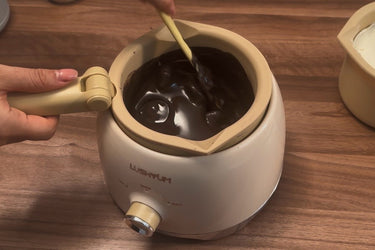Why Did My Candy/Chocolate Melts Get Hard? (And How to Fix It!)
If you've ever melted chocolate or candy melts only to find them turning thick, gritty, or rock-hard mid-process, you're not alone. Whether you're making dipped strawberries, cake pops, or drizzled treats, properly melted chocolate is smooth and glossy — not lumpy or stiff. So what went wrong?

Let’s break it down 👇
🍫 1. Water Got Into Your Chocolate (Seized Chocolate)
Even a single drop of water can turn your silky melted chocolate into a dry, grainy mess. This is called seizing. Candy melts aren’t technically chocolate, but they can react the same way when exposed to moisture.
Fix it:
Add a teaspoon of vegetable oil, shortening, or melted cocoa butter and stir gently to loosen the texture. But prevention is easier: keep your utensils and bowls bone dry!
🔥 2. Overheating the Chocolate
Chocolate and candy melts have delicate fats (like cocoa butter or palm oil) that don’t play well with high heat. If you melt them too fast or too hot, they can scorch or tighten up, becoming stiff and unworkable.
Fix it:
Use a low and steady heat source. That's why tools like the LUSHYUM Chocolate Melting Pot are great — they keep the temperature just right without burning the chocolate.
🍬 3. Wrong Type of Chocolate or Candy Melt
Some chocolates aren’t designed to melt smoothly — especially those with a high sugar or milk content (like chocolate chips). Candy melts are easier to work with, but still need gentle heat.
Fix it:
Choose melting wafers or couverture chocolate if you want the best fluid consistency. If using chocolate chips, add a teaspoon of oil for easier dipping.
⏱️ 4. Letting It Sit Too Long
Melted chocolate hardens as it cools. If you're not stirring or reheating it occasionally, it will start to thicken and set.
Fix it:
Keep your chocolate warm — either with a double boiler or a melting pot that maintains a low, steady temperature.
🔄 5. Using a Microwave Without Stirring
The microwave heats unevenly. If you microwave chocolate without pausing and stirring, parts of it may burn while others stay solid, leading to clumps or sudden hardening.
Fix it:
Melt in short bursts (15-20 seconds), stirring each time. Or use a dedicated melting pot for better control.
✅ Pro Tips for Silky Chocolate Every Time:
-
Always melt chocolate slowly.
-
Avoid water at all costs.
-
Use a silicone or wooden spatula — not metal (it retains heat too much).
-
Keep heat between 104°F–113°F for dark chocolate and 100°F–110°F for white/milk chocolate.
Bonus: Make It Easier with the Right Tools 🍫
If you’re tired of burnt, lumpy chocolate, consider using a chocolate melting pot that keeps the temperature low and consistent. The LUSHYUM Chocolate Melting Pot is designed exactly for this — beginner-friendly, compact, and mess-free. It’s great for home bakers, treat makers, and anyone making candy with kids.
Want more chocolate tips and tools?
Follow our blog for guides, recipes, and ways to upgrade your candy-making game!
Read More:
The Secret to Perfect Chocolate at Home: Easy Baking with the LUSHYUM Chocolate Melting Pot
Everything You Need to Know About Gummy Bear Molds: The Sweet Secret to Homemade Candy
How to Choose the Right Chocolate Fondue Pot for Sweet Success


